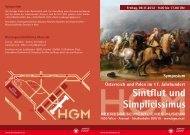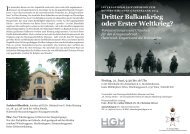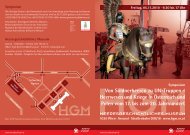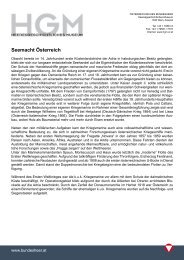Zum Saalzettel - Heeresgeschichtliches Museum Wien
Zum Saalzettel - Heeresgeschichtliches Museum Wien
Zum Saalzettel - Heeresgeschichtliches Museum Wien
Sie wollen auch ein ePaper? Erhöhen Sie die Reichweite Ihrer Titel.
YUMPU macht aus Druck-PDFs automatisch weboptimierte ePaper, die Google liebt.
Following mobilization of the troops and the ever increasing casualties of war, more and more men were being<br />
conscripted for military service. They left vacancies in all the areas of their employment, whether these<br />
were in industry, agriculture or other professions. Women fi ll these voids those that had previously already<br />
been burdened with their other work and everyday duties. Female tram-drivers, mail carriers and street<br />
maintenance workers were soon an everyday sight. The motivation of these women was however not always<br />
motivated just by patriotism as much more by necessity. Women had to face basically the main burden on the<br />
home front. They had to be proactive to support their families and so had no choice what kind of work they<br />
would be employed to do. Wherever the need or demand was greatest, that was where they would be sent<br />
– mostly with a lower salary. Factory owners argued that circumstance to the fact that women would afford<br />
less due to their weaker physical constitution.<br />
But some women thought that work outside the home were not just a burden, but also a chance for independence<br />
and self-realization. So they believed that as a direct result of the contributions made by women<br />
during the First World War, women will take a massive step toward achieving greater equal rights and freedoms.<br />
During the Assembly for Women’s Rights on March 24th 1918, Adelheid Popp presented her lecture<br />
and fi nally summed up the situation for women at the time with these simple words: ”Too stupid to vote, but<br />
clever enough to fulfi l their work requirements for the war effort”. She pointed out that women had been able<br />
to substitute men in most all areas of industry and had endured heavy workloads frequently under inhumane<br />
conditions. Conventional attitudes of a woman’s place being only in the home were at least out-dated and<br />
needed - in her opinion - a revision. They were soon to realize that their efforts and contributions to the war<br />
effort were merely seen as cheap substitutes for the missing men and upon the return of the men to the<br />
workforce, women were again delegated to nothing but low paying work.<br />
All text and pictures of this exhibition are primarily based on the originally by the Dolomitenfreunde at the <strong>Museum</strong><br />
Kötschach-Mauthen carried out exhibition “Women in War” in 2011. Objects of the museums-collection<br />
have been added.<br />
Gedruckt nach der Richtlinie „Druckerzeugnisse“<br />
des Österreichischen Umweltzeichens,<br />
BMLVS/Heeresdruckzentrum, UW-Nr. 943









